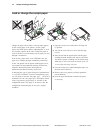
Chapter 2: About the Printer 11
A760-D100 10/04 189-9200303 Rev. D A760 Two-Color Thermal/Impact Hybrid Printer: User Guide
About the Ethernet Interface Option
Ethernet is a base band Local Area Network used to
connect multiple personal computers and peripherals
(stations) over twisted pairs of wire or co-axial cable. It
closely resembles IEEE 802.3 specification jointly
developed by Digital Equipment, Intel, and Xerox.
Originally invented by Xerox, Ethernet is a carrier sense,
multiple access, collision detect network (CSMA/CD). It
is designed to serve in networks with sporadic,
occasionally heavy traffic environments.
TPG, Inc.’s POS implementation is 10baseT. This
configuration of speed, cable, and connector design
allows installation and reconfiguration simplicity. Print
speed may be reduced during heavy network traffic
conditions. Some 100baseT (100Mbs) environments
can be supported if the network has implemented auto-
negotiation features that automatically down switch to a
10Mbs data rates, upon detection of slower attached
stations.
Summary of Design Features
• Ethernet Type 10baseT
• Speed 10Mb/sec
• Cable 2 twisted pairs. Maximum cable segment length
between stations is 100m.
• Connector Shielded RJ-45 communications connector will
provide peripheral shielding capability for twisted pair cables.
• Network Status LEDS Transmit active, Receive active, Link integrity, and Board select
• MAC address configuration Stored in EEROM
• IP address configuration Specify IP, BOOTP
• Protocol Support Raw TCP, LP, TELNET with binary and timing mark support
• Client Support Windows 95,98,2000,NT with standard Native.com serial
emulation port
Windows 95,98,2000,NT with TCP/IP implemented by customer
Windows 2000,NT with standard windows drivers
UNIX with TCP/IP implemented by customer
See “If installing the Ethernet communication cable” section, page 23 this manual and
“Ethernet terminology and setup” in the A760 User programming supplement, pages 14 and 136.


















